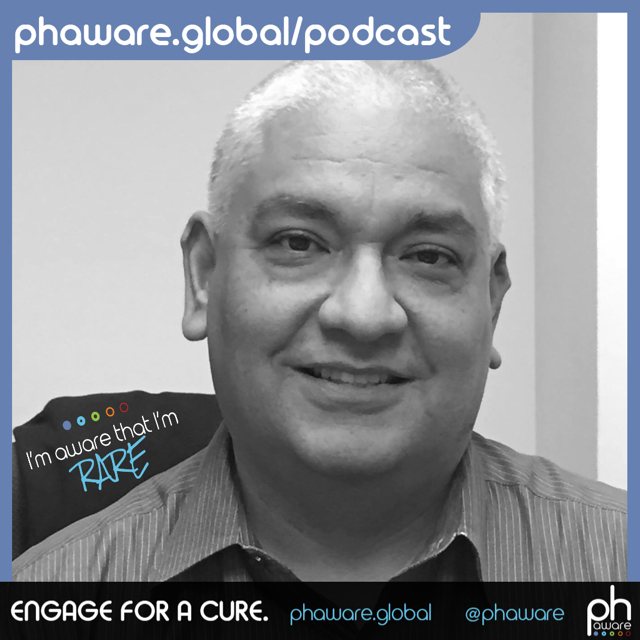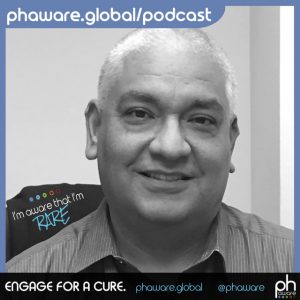Phaware Podcast: Juan Alejos, MD

This podcast series, created and produced by phaware, is being offered as a regular guest feature on Pulmonary Hypertension News to bring the voices and life experiences of PH patients, family members, caregivers, healthcare specialists, and others to our readers. You may listen to the podcast directly, or read it via the transcript that runs below.
I’m Aware That I’m Rare: Juan Alejos, MD
The phaware® interview (Episode 104)
Juan Alejos, MD, currently serves as the Medical Director of the Pediatric Heart Transplant/Cardiomyopathy Program at Mattel Children’s Hospital at UCLA. He is also the founder of Hearts With Hope, a non-profit, whose mission is to provide medical, dental and humanitarian assistance to children with congenital heart disease in the underserved global community. Dr. Alejos discusses the work of Hearts with Hope, whose next mission takes place Oct 30 to Nov 4 in Peru.
I’m Dr. Juan Alejos, I’m a pediatric cardiologist working at Mattel Children’s Hospital in UCLA, and director of the pediatric pulmonary hypertension program there.
Hearts With Hope is a non-profit organization we started about 11 years ago. Actually, initially the first steps were taken over 20 years ago after my father  passed away. My father was a pediatrician who trained in Peru. After he passed away in the early ’90s, I went back to visit where he had trained, kind of a connection with him. As I was leaving, I offered to come back and give lectures. The medical director of the only children’s hospital in Peru told me, “instead of giving lectures we would much rather have you show us what you do.”
passed away. My father was a pediatrician who trained in Peru. After he passed away in the early ’90s, I went back to visit where he had trained, kind of a connection with him. As I was leaving, I offered to come back and give lectures. The medical director of the only children’s hospital in Peru told me, “instead of giving lectures we would much rather have you show us what you do.”
The idea had never struck me before. The first mission, I went back withother cardiologists, and a surgeon and we did a few cases. Once I did that the first time, I kind of caught the fever. I’ve been working at that ever since. I think I took about a five-year break just due to manpower issues here in the states, in terms of my hospital. I really couldn’t get away. Once I started again, I realized I needed to form my own non-profit.
We started out covering South America and Latin America. We went to El Salvador. We’re going to Honduras, Bolivia. Now we changed our mission statement once we found out that we were successful. We actually went to the Philippines last year.
What we found out, or what we realized was you can bring one child over here and do the surgery, let’s say at UCLA or any other hospital at a cost of $150,000, $200,000 depending on how complicated it is. … For that same, let’s say $100,000, we can treat probably about 40 kids in an underdeveloped country. We can treat about 40 children or more.
Basically, our only limitation … is not the funding; it’s actually the time. It’s a much better situation, you can do a complete cardiac surgery in Peru for instance, for about $5,000 from start to finish, which here in the United States would barely let you sit on a hospital bed for five minutes. It definitely showed us that our dollar can go a lot further. Every donated dollar could go a lot further.
Our goal, when we do this is, we don’t go and take over. We go and work alongside physicians, and nurses, the echo techs, basically the whole healthcare team. In the other country, we go and work alongside of them. We make a ten-year commitment wherever we go with the idea that we’re helping them develop a program.
We tend to go to the same hospital in the city when we develop a relationship with them. We kind of develop a team, work with a team that’s local. Basically, they become the scouts and find patients that we should consider. Then we work with them to evaluate them, that we can then have our cases. As we do that, we’re actually teaching them, that hospital, how to select cases; what kinds of patients are good, what kind of patients are good surgical candidates, what kind of patients are not good surgical candidates.
We’ve seen for instance, in one city in Peru the first year we went, they presented us with a list of 50 patients, of which I believe 40 of them were not operable candidates, just for different reasons. Some of them had pulmonary hypertension, some of them had other reasons that made them not candidates for congenital heart surgery. In this last year, of the ones they showed us, 49 of the 50 were operative candidates. They’ve come a long way in their screening. That’s our goal, is to teach them to be able to do all this. They’ve done some really impressive things, which is a really good feeling for us here. It just shows that we’ve given them the confidence to go ahead and do this on their own.
The biggest thing is supplies. For instance, a lot of supplies that we use here, the cost for them is the same here as it is there. The income for people, let’s say in Peru, is much lower, so it’s very difficult for them. When they were developing an insurance program for children, which included things like congenital conditions – since they did not consider congenital heart disease in that group. They thought that there’s no way that it could be successful. Since then we’ve managed to change their minds, so now they have an insurance program.
Still, they have shortages of supplies. They just don’t have the organization that we have here and the budget. Basically, they replace supplies as they use them instead of, for instance here, where we have a central supply where we have 20 of this or 20 of that. As they use them, they order another one. It depends on it going through all the bureaucracy of the government approving the purchase and then finally buying them. They actually may operate for a month and then be stuck waiting for supplies to come in so they can do any more surgery.
Word spreads
The first time I went with just the three of us, I recruited a few people who I work with who were interested. Kind of went with a small group of six or eight people including nurses, including anesthesiologists. I think people would hear us as we came back, just the discussions, as people heard they became interested. The mission began to grow more and more, to the point where one of our missions is a two-week mission where we take 70 people. That we expanded to include dentistry, and basically had more people than we had spots.
As time progressed, people started finding us on the internet or by word of mouth, and we started getting interest from other people in other countries. We have a cardiologist from Israel, (another) from Spain, who have accompanied us. We have students, undergrads, medical students and residents, and it’s just continued to grow. I consider that to be an important part for us as well. I realize I can’t do this forever, and I want to hopefully inspire some of the younger doctors coming out that this is something feasible to do.
The interesting thing is one of our team members who went with us, who goes with us on missions regularly now, is Peruvian, and he was very pessimistic that something like this could work. Then when he went on one mission, he turned around and told everybody, “I was totally wrong.” He realizes our goal, we’re not going to fix every single heart lesion that’s out there, but we’re inspiring them so they can feel like they can.
They are making progress. Right now, we pretty much have a long list of people and people email us along the way saying they’re interested if we ever have a spot. When we plan a mission, we fill it with return people first and then we go back to those people and ask them if they’re interested or able to fill our missions. We have a lot of what we call veterans who have been with us on multiple missions and keep coming back looking for more.
I realize in a way, we’ve had kids that we don’t treat, that would basically not be candidates for surgery here, we would be very conservative here. Unfortunately, there we don’t have the luxury, because we don’t have the time to wait three weeks for surgery, because we’re not going to be there.
Then we realize that is the most difficult part, being the person who assesses and decides who needs surgery, who gets surgery, and who doesn’t. We have a limited number of spots and limited time. For us, we try to be as impartial as possible and basically look at which kids can wait another year. We try to communicate with them. I guess the two things that stand out to me is, one of them we found out that in certain countries, unlike United Sates where if you lose your cell phone you can keep your cell number, in some countries it’s just easier if you lose your cell phone or it gets stolen is to just get a brand-new number.
A lot of families that we try to reach out to the next year, their cell phones numbers they’d lost and they’d changed so we couldn’t get a hold of them. We realized that we learned our lesson, that we had to start asking for not just cell phone numbers but landlines, and relatives, and friends. We basically left with each patient with half a dozen numbers so that we can get a hold of them when we came back.
The other story for me was, we saw a little baby one year. On the first day, the baby had probably croup or had a bad respiratory illness. Typically, here we would have sent the baby home and said come back a couple weeks after the illness clears. If we did, we would have been gone, nobody there could do the surgery. This baby’s lesion, basically he wouldn’t be alive the next year for us to come back to operate on.
We admitted the baby and gave him antibiotics, and hydration, and respiratory treatments. One week after doing that, we went and met with the family, with the surgeon, anesthesia. We told them we were willing to do the surgery, take the risk. The family understood what the risk was, that the baby may not survive the surgery. We did the surgery that Monday and the baby flew and was home by Friday.
That’s a good feeling, knowing that we’re helping people. That’s what we’re trained to do, not because there’s a paycheck, or a salary, or any reward out of it. These families were so grateful, they bring you small gifts — chocolate, bread. Things that are special to them just out of complete, total gratitude.
That’s a really special feeling, it makes you really realize what we’re doing is just what we were trained to do. We’re not dealing with insurance authorization or anything like that, we’re dealing entirely with the child’s life and the fact that we have the ability to save it.
My name is Juan Alejos, and I’m Aware That I’m Rare.
EVERYBODY HAS A STORY. WHAT’S YOURS?
Phaware global association wants to share your pulmonary hypertension story with their engaged global audience. Whether you are a patient, caregiver, or medical professional, they are enlisting PH community members from around the world. Visit www.phawarepodcast.libsyn.com/contact to share your story and to be considered for a future episode. Never miss an episode with the phaware® podcast app. Learn more about pulmonary hypertension at www.phaware.global. #phaware
***
Note: Pulmonary Hypertension News is strictly a news and information website about the disease. It does not provide medical advice, diagnosis, or treatment. This content is not intended to be a substitute for professional medical advice, diagnosis, or treatment. Always seek the advice of your physician or other qualified health provider with any questions you may have regarding a medical condition. Never disregard professional medical advice or delay in seeking it because of something you have read on this website. The opinions expressed in this column are not those of Pulmonary Hypertension News or its parent company, Bionews Services, and are intended to spark discussion about issues pertaining to pulmonary hypertension.










Morton Lennox
Shared! I'm pretty sure a few friends would like to read this.